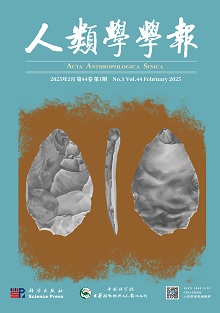The living environment of home erectus from Tangshan, Nanjing and other sites
XU Qinqi
1999, 18(04):
263-269.
 Asbtract
(
338 )
Asbtract
(
338 )
 PDF (199KB)
(
204
)
Related Articles |
Metrics
PDF (199KB)
(
204
)
Related Articles |
Metrics
There are many paleoanthropological sites in South China, such as Yuanmou, Yunxian, Nanjing , Hexian, Chaoxian, etc.
The date of the fossil hominid crania from Tangshan, Nanjing , and the Tangshan fauna corresponds to the late stage of the Peking Man fauna in Zhoukoudian, i. e. the Middle Pleistocene ( 0. 127— 0. 5Ma) . The Tangshan fauna is a monotonous one o f northern type, because all the 15 species found in Tangshan are also members of the Peking Man fauna. So the Tangshan fauna must have been living during a period which corresponding to the cold stage and might be at oxygeniso to pestage 10 ( 0. 33— 0. 37 M a).
The geological age of the hominid skulls from Yunxian, Hubei, and the Yunxian fauna can be correlated with the Gongwang ling fauna, i. e. the Early Pleistocene ( 1. 0— 1. 4 Ma) . All the 23 species found in Yunxian are southern elements o f China, so it is a fauna o f southern and northern type. Both the Yunxian and Gongwang ling fauna must have been living during a warm stage, corresponding to the Waalian warm stage in Europe.
The Yuanmou site is the oldest one among the paleoanthropological sites in China. The Yuanmou fauna (i. e. the Fourth M ember of the Yuanmou Formation) includes 29 species. Many of them are the northern mammals, such as Ochotonoides complicidens, Megantereon nihowanensis, Eostyloceros, Metacervulus capreolinus, Muntiacus lacustris, Paracervulus attenuatus,Cervavitus, Axis shansius, A .rugosus, Rusa , Procapreolus, Gazella , etc. They w ere living in North China during the Early Pleistocene and the Pliocene. So the age of the Yuanmou fauna corresponds to the Early Pleistocene ( 1. 4— 1. 90 Ma ) and must have been living in a cold stage. Many scientists argued that this cold stag e ( at about 1. 6 Ma ) represents the beginning o f the Pleistocene ( Backman et al. , 1983; Shackleton et al. , 1984).









